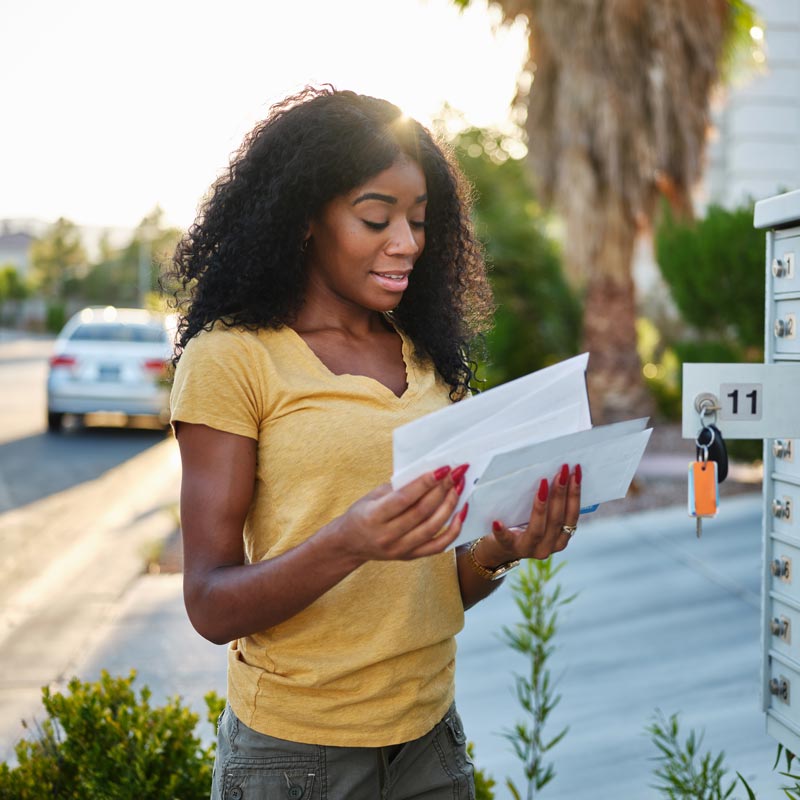Scams sent through the United States Postal Service (USPS) are mail fraud. They exist in the form of a postcard, brochure, or letter. If you respond, you become part of a scheme that uses sophisticated sales tactics and technology to trick you out of your money or personal information. The most common types of mail fraud are:
Imposter scams
In these schemes, scammers contact you pretending to be from a government agency, financial institution, or utility company. If they demand payment or your personal information, don’t respond. Never give out personal information to anyone you do not know or have not verified. If you’re not sure, look up the official contact information for the agency, bank, or company the sender claims to represent and contact them directly to confirm the mail’s legitimacy. Or bring in the mail piece to the mailer to confirm it’s legitimate. Signs of an imposter scam include:
- Offers that seem too good to be true, like a new credit card without a credit check, an advance on a loan, or an amazing deal on a product or service.
- Requests for personal information, bank details, or a payment before you can access the deal being offered.
- The mailed item uses vague language, or your account information is not complete. The mailer is asking for information, rather than providing it.
- Spoof websites (or logos) – make sure you’re on the right site.
Sweepstakes, lotteries, and prizes
In these tactics, scammers claim you’re a winner, but what they really want is your money or personal information. It starts with a postcard or letter, often appearing to be from a recognizable organization, asking you to contact them to claim your prize. They promise prizes like cars, vacations, or large sums of money. Before taking action, verify the winnings directly from the source, not via the phone number or website sent to you in the mail. If you don’t recognize the sender or organization, conduct an independent search to verify its legitimacy. More signs it’s a scam:
- You get contacted by a contest you did not enter.
- There is pressure to act immediately.
- You must send money or pay taxes to collect your winnings.
Unsolicited mail
With these scams, swindlers send mail offering products or services at unusually low prices, phony inheritance notifications, or ask for payment for free services. These scams use mail to help persuade people. Recognize the signs:
- Postcards or brochures that describe an appealing offer and ask you to call a toll-free number. When you call, the telemarketer has a convincing sales pitch and uses high-pressure tactics to trick you into buying fake products and services or giving your personal information.
- The USPS does not have a mechanism to filter mail, like the National Do Not Call Registry. However, you do have the right to ask a telemarketer to stop calling you and to be removed from its list.
Mail theft
Mail fraud can also come in the form of theft. Scammers use the urgency of a missing letter or package to get you to contact them. Then, ask you for money or your personal information in order to get the stolen item. Some ways to protect yourself:
- If you receive a text or call about a package you are not expecting, don’t click any links, block and report it. The USPS will never call or text you – they will mail notices to you.
- Never send cash in the mail. Mail payments at a post office or in an official blue USPS mailbox. Never leave outgoing mail in your residential mailbox overnight. Collect your mail and packages as soon as possible. Shred all unwanted mail and personal documents.
- Use mail tracking services, like Informed Delivery, to track your mail.
Submit a complaint
Mail fraud is a federal crime. If you have questions about a mail scam or theft, call the United States Postal Inspection Service (USPIS) hotline at 877-876-2455 x2.
If you think you might have been involved in a mail scam or theft, or you believe you are being harassed through the mail, submit an online report.
Provide as much evidence as possible in your report, like surveillance video of someone stealing your package. How many people were involved? Was there a vehicle? Give a description of the item that was stolen with a date or timestamp. If a check was stolen, provide the check number, amount, and name of the bank. The more information you can provide, the better the chances your money or package can be recovered.
